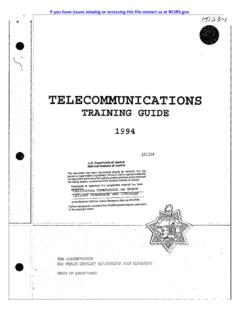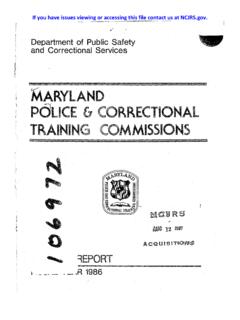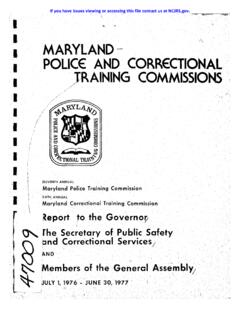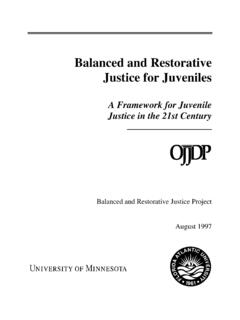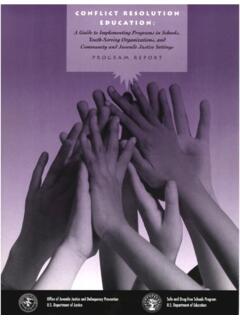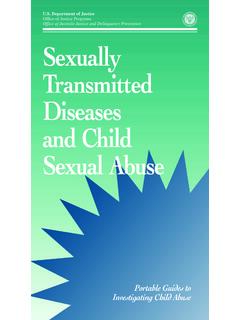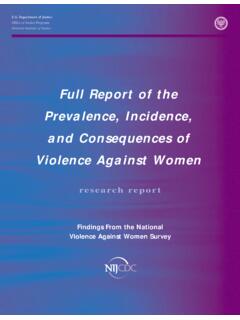Transcription of CHAPTER 5 Corrections - NCJRS
1 CHAPTER 5 CorrectionsThe field of Corrections addressed in this section includes the adultand juvenile justice agencies responsible for the incarceration,detention, supervision, and surveillance of those accused or convictedof committing crimes. The Corrections system encompasses institu-tional Corrections our nation s prison system and facilities such asjails that temporarily confine those accused or convicted of Corrections includes probation , an alternative sentence tojail or prison/detention, as well as paroling authorities which haveresponsibility for hearings on releasing offenders from incarceration ordetention and supervision following is no standard organizational model defining the relationshipsbetween correctional agencies on the state or federal level. In somestates, the institutional correctional agency not only manages theprisons but has responsibility for parole release decisions and paroleesupervision.
2 In other states, the paroling authority is separate from thestate s institutional correctional agency. For purposes of this section,institutional correctionsrefers to prisons and jails, and communitycorrectionsrefers to probation and recent years,America s correctional population has grown 7 to 8percent annually and is now triple the 1980 population, with approxi-mately million individuals under some form of correctional the total correctional population, about 75 percent is undersupervision within the those incarcerated, about two-thirds are in federal and state prisons, and one-third are in local Final Reportof the President s Task Force did not includerecommendations for institutional Corrections or probation , and madeonly four recommendations for Task Force urged paroleboards to: Notify victims of crime and their families in advance of parolehearings, if names and addresses have been previously provided bythese individuals.
3 Allow victims of crime, their families, or their representatives toattend parole hearings and make known the effect of the offender scrime on have had a tendencyin Corrections really notto give a priority level tovictims of crime. For solong, it was secondary toother considerations. Inmore recent years, wehave realized that victimsshould be at the top ofour agendas and part ofall of the efforts we areinvolved Thigpen, Director, National Institute of Corrections119 CHAPTER 5: Corrections Take whatever steps are necessary to ensure that parolees chargedwith a crime while on parole are immediately returned to custodyand kept there until the case is adjudicated. Not apply the exclusionary rule to parole revocation narrow scope of the Task Force recommendations was largely areflection of the the early 1980s,victims rights and services incorrections were virtually to increase victim partic-ipation largely addressed the front end of the criminal justice system,affecting the roles and responsibilities of law enforcement,prosecution,and the the exception of enacting rights for victims tosubmit victim impact statements at parole hearings,victims rights andservices within adult and juvenile Corrections were largely Role of Victims in Institutional andCommunity Corrections Over the past decade,the basic philosophy of correctional agencieshas undergone radical ,correctional agenciesviewed their role as limited to punishing and attempting to.
4 Serving crime victims is also widely accepted as animportant part of the mission of correctional new role isreflected in their governing laws and internal policies and procedures,as well as in the attitudes of correctional reforms mandating that correctional agencies providespecific services to victims of crime have substantially increased thescope of victims rights and services in a result,manycorrectional agencies have gained an understanding of crime victims needs and developed policies and procedures sensitive to those agencies now interpret their responsibility to protect thepublic as including individual crime increasing number of offenders in the nation s correctionalsystems since 1982,when the President s Task Force Final Reportwasissued,has had an enormous impact on institutional ,there were a little more than 400,000 inmates in federal andstate prisons in the United 1996,this number had quadru-pled to ,correctional institutions are realizing that victims areimportant significant steps toward this goal were theincorporation of service to crime victims in mission statements and thecreation of victim advisory boards,both of which help guide the overalloperation of correctional agencies now provide aWe have been in denialin essence about the roleof the victims in correc-tions itself.
5 Correctionshas probably been the lastmajor entity in thecriminal justice system toreally get involved withvictims issues. So asPresident, I really wantthe American Correc-tional Association toembrace the notion ofvictims issues, victims rights, and the role ofvictim A. Wilkinson,Director, Ohio Department ofRehabilitation and correction ,President, American Correc-tional Association 120 Section 2: New Directions for Criminal and Juvenile Justice System AgenciesChronology of Corrections Response to Crime VictimsIt is noteworthy that the many accomplishments in the area of Corrections -based victim serviceshave been achieved through strong leadership emerging from national Corrections partnerships they have forged with victim service organizations have been critical to promot-ing an agenda for victims rights and services throughout the nation s correctional new sensitivity to crime victims emerged in the mid-1980s with the following events.
6 In 1986,the American Correctional Association published a landmark policy statement pronounc-ing that victims have the right to be treated with dignity and respect and the right to notificationof their offenders status. In 1987,the American Correctional Association established a victims task force which published15 recommendations to improve correctional-based victims recommendationsprovided a comprehensive national foundation for victims rights and services in Corrections . From 1990 to 1994,the Office for Victims of Crime supported the first national crime victimsand Corrections training and technical assistance ,more than 40 states,aswell as the federal and military Corrections systems,have received training,technical assist-ance,and support in developing policies and procedures to initiate and enhance Corrections -based victim services.
7 In 1990,the first national conference on Corrections -based victim services,sponsored by the Officefor Victims of Crime,was held in Sacramento,California,with 150 participants from 40 states. In 1991,both the American probation and Parole Association and the Association of ParolingAuthorities,International,establ ished victim issues committees. In 1995,the American Correctional Association Victims Committee issued the landmark Reportand Recommendations on Victims of Juvenile Offenders,recommending that the rights ofvictims of juvenile offenders mirror those of adult In 1995,the Office for Victims of Crime initiated four projects as a continuation of the workstarted in 1990:two grants to fund promising practices in victim services in Corrections and jailsand in probation and parole,and two training-for-trainers projects on work-related violence andvictim services in Corrections .
8 In 1996,the Association of State Correctional Administrators formed a victims committee thatworks closely with the Office for Victims of Crime to integrate victim service programs intocorrectional agencies and work sites across the country. In 1997,the Federal Bureau of Prisons formed a Crime Victims Working Group to develop a long-range plan on how the Bureau can better address victims 5: Correctionsvariety of services to victims including victim notification of offenderstatus,restitution collection,protection from intimidation and physicalharm,and innovative victim impact programs to help educate offendersabout the impact of the crimes they have creativeprograms and services are discussed in detail later in this the United States,jails typically hold men and women who areawaiting trial or serving sentences of one year or 1996,local jailauthorities held or supervised an estimated 591,459 men and women,of whom 12 percent (72,977)
9 Were supervised through such programsas community service,work release,weekend reporting,electronicmonitoring,and other alternatives to more jails being used as longer term incarceration facilities forconvicted offenders,it is paramount that jails also provide basicservices for crime victims such as notification of changes in offenderstatus and collection of court-ordered personnel alsohave a responsibility to protect the safety of victims by notifying themof the pending release of an alleged or convicted or witnesses complain to jails about harassment or retaliationby alleged or convicted offenders under their supervision,jail person-nel must respond 1996 survey of jails in mega,large,and medium jurisdictions nation-wide found,however,that implementation of basic victims services,while improving,is still far from an acceptable the jailsresponding to the survey,less than 50 percent have specifically assigneda staff member to handle inquiries from crime victims or witnesses andto provide information to addition,30 percent of jails do notnotify victims and witnesses about the status of offenders or of anoffender s scheduled release from incarceration,and 50 percent do notnotify victims and witnesses of an offender s early release or CorrectionsThe underlying philosophy of community Corrections is also rights and services for crime victims at this criticaljuncture of the criminal and juvenile justice processes is taking onincreasing importance because probation is now the most widely usedcorrectional tool,and its use is increasing at a faster rate than any otherform of 1994.
10 Of the estimated million individualsunder some form of Corrections in the United States,75 percent wereunder community those under community Corrections ,60percent were on probation and 15 percent were on ,asthe rate of incarceration in our nation s prisons dramatically increases,community Corrections increasingly is used as a spillway for number of probationand parole professionalsthat need to place crimevictims on a more evenplaying field with offend-ers is increasing afterall, it is the right and justthing to do. Albeit it notalways the easiest thing todo. The victims rightsmovement continues to bea powerful force, andcommunity correctionsmust rise to the challengebeing presented or risklosing their credibilitywith the public as well as risk losing muchneeded probation and Parole Association, Promising Victim-Related Practices forProbation and Parole,February 14, 1997122 Section 2.

